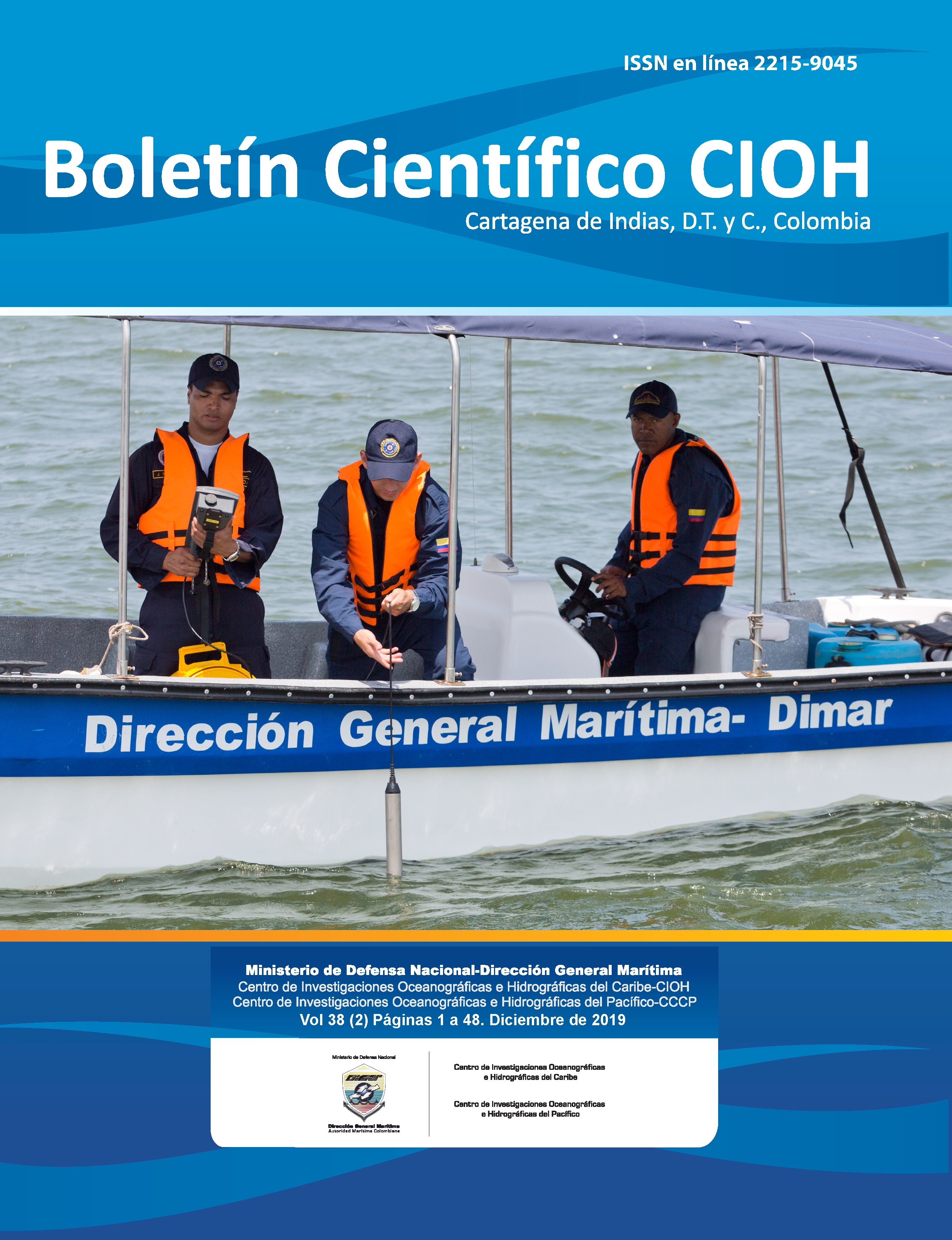VALIDATION AND IMPLEMENTATION OF AN OPERATIONAL TOOL FOR TIDE FORECAST IN THE COLOMBIAN PACIFIC (ISLA GORGONA CASE STUDY)
DOI:
https://doi.org/10.26640/22159045.2019.521Keywords:
nivel del mar, marea astronómica, análisis armónico, FFT (Fourier), coeficiente de Courtier, pronóstico de mareasAbstract
This paper describes the validation and operational implementation of a computer tool in the Colombian Pacific (Graphical User Interface); this application called the Colombian Pacific Tide Forecast (PROMARPACO), is currently operated from the Operational Oceanography Area of the Oceanographic and Hydrographic Pacific Research Center (CIOH Pacific (CCCP)), being in the verification and testing stage. The process of characterization of the tidal behavior on the main ports of the Colombian Pacific was carried out through harmonic analysis techniques, Fast Fourier Transform (FFT) and the Courtier coefficient, applied to the time series of sea level belonging to the tidal stations of the Network of Measurement of Oceanographic Parameters and Marine Meteorology of the General Maritime Directorate (REDPOMM), taking as a case study for this article the Gorgona Island. As a result, the operability and functionality of the PROMARPACO tool is presented, which serves as support to DIMAR for the control and verification of the maritime activities carried out in the Colombian Pacific basin.Downloads
References
Burling, M. P. (2003). The tidal regime of Shark Bay, Western Australia, Estuarine,Coastal and Shelf Science, 57, 725–735, 2003. Australia.
Carrillo, C. J. (2003). Fundamentos del Análisis de Fourier. Vigo, España.
Defant, A. (1958). Ebb and flow. Ann Arbour, MI: University of Michigan Press.
Díaz Gómez, M. A. (2009). cybertesis.uach.cl. Retrieved 02 25, 2012
Foreman, M. (1977). Manual for Tidal Heights Analisys and Prediction, Pacific Marine Science Report 7710, Institute. Sidney, Patricia bay, Australia.
French, P. W. (1997). Coastal and estuarine management. Routledge, Londres .
Fuentes, J. E. (2011). Detrminacion del nivel medio y extremo del nivel del mar en esteron y rios con dinamica mareal el la bahia de Tumaco. Boletín Científico CIOH NO. 29, ISSN 0120-0542, 110-121.
INVEMAR, I. d. (2001). Gorgona Marina: Contribución al conocimiento de una isla única. (L. Barrios, & L.-V. M, Eds.) Santa Marta, Colombia.
Leffler, K.E. and Jay, D. A. (2009). Enhancing tidal harmonic analysis: Robust(hybrid L1=L2) solutions,Continental Shelf Research., 29, 78- 88. 2009.
Lehman, A. O. (2005). JMP for Basic Univariate and Multivariate Statistics: A Step-by-step Guide.
Macdonel, G. P. (2000). Ingeniería Marítima y Portuaria. Cataluña, España: Alfaomega.
Macnillan, D. (1966). Tides. Londres : CR Books Limited .
Naveda, J. (2011). Variación en el nivel del mar como censecuencia del cambio climático global: Una evaluación de la costa Venezolana. Temas de Coyuntura, 61-85.
Otero, L. (2005). Metodología para establecer la línea de más alta marea en aguas abrigadas (bahías, estuarios, etc.) cuando no se tienen registros instrumentales. Informe Técnico, Centro de Investigaciones Ocenográficas e Hidrográficas del Pacífico- CIOHP, Tumaco, Colombia.
Pawlowicz, R. (2002). Classical tidal harmonic analysis with errors in matlab using t-tide, Computers & Geosciences, 28, 929–937, 2002.
Pugh, D. T. (1987). Tides, surges and mean sea-level: A handbook forengineers and scientists. Chichester, United Kingdom.
Rasilla, D., García, J., & Hernández, A. (2004). Las mareas atmosféricas en la costa norte de la Peninsula Ibérica. El Clima entre el Mar y la Montaña(4), 135-144.
Rosenfeld, L. (2009). Methodology for a regional tidal model evaluation, with application to central California deep sea research part II, Tropical estudies in oceanography pag 199-218.
Singh, A., & Aung, T. (2005). Effect of barometric pressure on sea level variations in the Pacific region. The South Pacific Journal of Natural Science, 9-15.
Downloads
Published
Issue
Section
License
Copyright (c) 2019 Boletín Científico CIOH

This work is licensed under a Creative Commons Attribution-NonCommercial-NoDerivatives 4.0 International License.
Attribution — You must give appropriate credit, provide a link to the license, and indicate if changes were made. You may do so in any reasonable manner, but not in any way that suggests the licensor endorses you or your use.
NonCommercial — You may not use the material for commercial purposes.
NoDerivatives — If you remix, transform, or build upon the material, you may not distribute the modified material.
No additional restrictions — You may not apply legal terms or technological measures that legally restrict others from doing anything the license permits.



